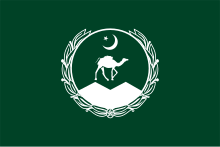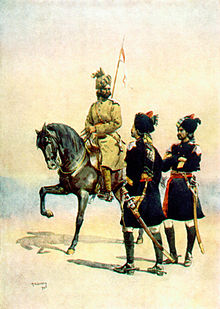バローチ人
表示
(バロチ族から転送)
| بلوچ Balōč | |
|---|---|
 | |
 バローチ人 | |
| 総人口 | |
| 約1000万人 (2013)[1] | |
| 居住地域 | |
| パキスタン | 680 万 (2017)[2] |
| イラン | 150 万–200 万 (2013)[1] |
| アラブ首長国連邦 | 468,000 (2014)[3] |
| アフガニスタン | 50万-200 万[4][5] |
| トルクメニスタン | 100,000 [6] |
| 言語 | |
| バローチー語, ブラフイ語, ジャガリ語 ペルシア語, アラビア語 (spoken by locality) | |
| 宗教 | |
| イスラム教 (majority), ヒンディー語, シク教 (minority) | |
バローチ人(バローチじん、英語: Baloch, バローチー語: بلوچ, ローマ字表記Balōč; or Baluch)は、主にパキスタン、イラン、アフガニスタンのバローチスターン域に居住するイラン系民族[7]である。インド[8]やアラビア半島など近隣にも四散したバローチ人のコミュニティがある。
大イランの南東に居住するにもかかわらず、主に、西イラン語群に属すバローチー語を話す。バローチ人の総人口の約50%はパキスタン西部の州であるバローチスターン州に住んでいる[9]。バローチ人の人口の40%はシンド州に定住し、かなりの数のバローチ人がパキスタンのパンジャブに住んでいる。 彼らはパキスタンの人口のほぼ3.6%、イランの人口の約2%(150万人)、そしてアフガニスタンの人口の約2%を占めている[10]。
遺伝子
[編集]バローチ人のY染色体ハプログループは、Grugni et al.(2012)の研究では、ハプログループJが最も高い頻度(41.6%)を示し、R1a(25%)、L(16.6%)、R1*(R1a,R1bを除く)、Q、E、Gがそれぞれ4.2%を占めるという結果が得られた[11]。一方、2006年に行われた別の研究では、R1a(28%)、L(24%)、J(16%) 、R2(12%)、R1b(8%)、E(8%)、H(4%)といった構成が報告されている[12]。

脚注
[編集]- ^ a b “Iran Minorities 2: Ethnic Diversity”. The Iran Primer. United States Institute of Peace. 3 September 2013閲覧。 “Baluchis number between 4 million in Iran. They are part of a wider regional population of about 10 million spread across Iran, Pakistan, and Afghanistan.”
- ^ “Number of Balochi-speaking people in Balochistan falls”. Dawn News. 11 September 2017閲覧。 “However, the total number of Baloch people has increased from 4 million in 1998 to 6.86m in 2017. The count does not include the population of two districts — Quetta and Sibi — where people of various ethnicities, including Baloch and Pashtun also reside.”
- ^ “United Arab Emirates: Languages”. Ethnologue.com. 24 October 2016閲覧。
- ^ Karlos Zurutuza. “Pakistani Baloch find home in Afghanistan”. Al Jazeera. 17 September 2014閲覧。 “In the absence of comprehensive census data, an estimate by Professor Abdul Sattar Purdely puts the population of Afghan Baloch at about two million.”
- ^ “Cultural Orientation Balochi”. Defense Language Institute Foreign Language Center. p. 111. 2020年12月31日閲覧。 “An estimated 500,000–600,000 Baloch live in southern Afghanistan, concentrated in southern Nimroz Province, and to a lesser degree in Helmand and Kandahar provinces.”
- ^ KOKAISLOVÁ, Pavla, KOKAISL Petr. Ethnic Identity of The Baloch People. Central Asia and The Caucasus. Journal of Social and Political Studies. Volume 13, Issue 3, 2012, p. 45-55., ISSN 1404-6091
- ^ Zehi, Pirmohamad. “A Cultural Anthropology of Baluchis”. Iran Chamber Society. 2020年12月31日閲覧。
- ^ Badalkhan, Sabir. "A Brief Introduction to Balochi Literature". Uppsala University.
- ^ Blood, Peter, ed. "Baloch". Pakistan: A Country Study. Washington: GPO for the Library of Congress, 1995.
- ^ Central Intelligence Agency (2013年). “The World Factbook: Ethnic Groups”. 3 November 2014閲覧。
- ^ Grugni, Viola; Battaglia, Vincenza; Kashani, Baharak Hooshiar; Parolo, Silvia; Al-Zahery, Nadia; Achilli, Alessandro; Olivieri, Anna; Gandini, Francesca et al. (2012-07-18). “Ancient Migratory Events in the Middle East: New Clues from the Y-Chromosome Variation of Modern Iranians” (英語). PLOS ONE 7 (7): e41252. doi:10.1371/journal.pone.0041252. ISSN 1932-6203. PMC 3399854. PMID 22815981.
- ^ Sengupta, Sanghamitra; Zhivotovsky, Lev A.; King, Roy; Mehdi, S.Q.; Edmonds, Christopher A.; Chow, Cheryl-Emiliane T.; Lin, Alice A.; Mitra, Mitashree et al. (2006-02). “Polarity and Temporality of High-Resolution Y-Chromosome Distributions in India Identify Both Indigenous and Exogenous Expansions and Reveal Minor Genetic Influence of Central Asian Pastoralists”. The American Journal of Human Genetics 78 (2): 202–221. doi:10.1086/499411. ISSN 0002-9297. PMC 1380230. PMID 16400607.

